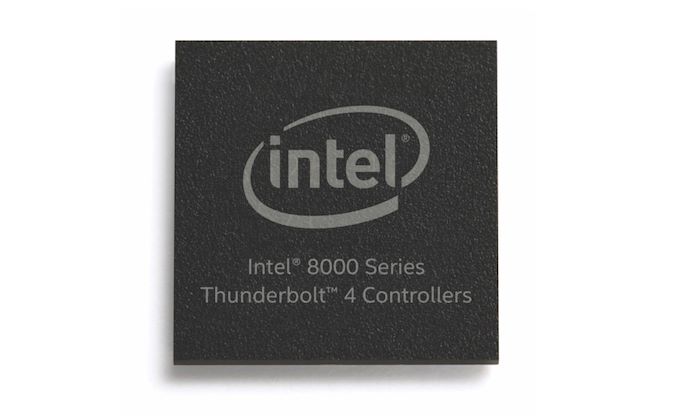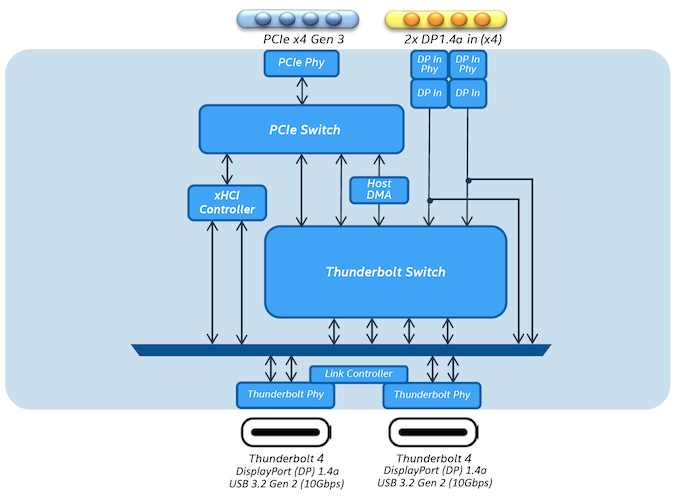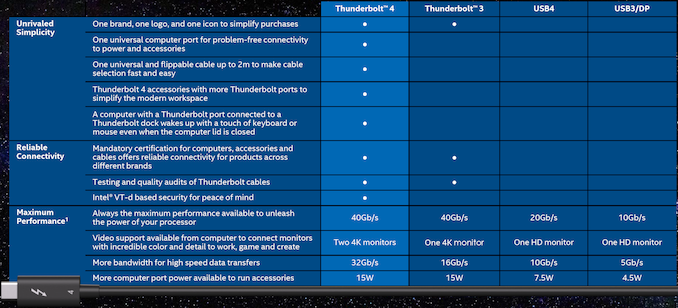Intel's Maple Ridge (JHL8540) Thunderbolt 4 Controller Now Shipping
by Ganesh T S on December 23, 2020 8:15 AM EST- Posted in
- Thunderbolt
- Intel
- DisplayPort
- Thunderbolt 4
- Maple Ridge

Following the launch of Thunderbolt 4 earlier this year as part of Intel's Tiger Lake CPUs, the next piece of the TB4 hardware stack has dropped this week with the release of Intel's first stand-alone Thunderbolt 4 controller, Maple Ridge (JHL8540). Previously announced back in July as part of Thunderbolt 4's reveal, Intel this week updated their Ark database to add a product page for the Maple Ridge controller family and flag that the first part is now shipping. With the release of the discrete Thunderbolt 4 controller, it will now be possible for hardware vendors to build TB4 hosts with additional ports, or in devices not using Intel's Tiger Lake Silicon.
This late-December launch follow's Intel's previous roadmap, which had the launch of standalone controllers set to take place before the end of 2020. These included the Goshen Ridge (JHL8440) device controller – for use in docks and peripherals, and the Maple Ridge (JHL8540 and JHL8340) host controllers – for use in computers, tablets, and other client devices. Goshen Ridge went into production soon after the announcement. And with the release of Maple Ridge Intel has also kept its promise here, getting it out just prior to the end of the year.
For quite some time, Thunderbolt ports were found only on systems with Intel processors. However, last year we saw vendors such as ASRock innovate with the introduction of a Thunderbolt 3 port on the X570 Phantom Gaming-ITX/TB3, an AMD Ryzen platform motherboard. This was followed a few months back by the introduction of M1-based Macs featuring Thunderbolt 3 (backed by Apple's in-house controllers). The use of Maple Ridge will now enable motherboard vendors to create systems with Thunderbolt 4 ports that do not necessarily need to be based on Intel processors.
The JHL8540 Maple Ridge controller interfaces with the host processor using a PCIe 3.0 x4 link and also takes in two Display Port 1.4a inputs. On the downstream side, the controller enables two Thunderbolt 4 ports, which along with their native Thunderbolt (packet encapsulation) abilities can also be used as straight-up USB4 ports, or as DisplayPorts via USB-C's DP alt mode.
The PCIe switch and, in general, the PCIe support in Maple Ridge has been updated to work with many optional features, keeping security in mind and the rich variety of PCIe devices coming into the market. For example, Maple Ridge includes PCIe peer-to-peer support which allows two PCIe devices connected to the two Thunderbolt 4 ports to exchange data with each other without having to make it travel upstream to the host RAM. From a security viewpoint, Access Control Services (ACS) is also supported to provide isolation between different sets of PCIe devices and make them always go through the IOMMU. Precision Time Measurement (PTM) is also a supported feature, allowing different downstream PCIe devices to accurately synchronize with each other and the host system.
It must be noted that Thunderbolt 4 brings more guaranteed bandwidth to end-users. With Thunderbolt 3, device vendors could skimp on the connection of the controller to the host processor – using only a PCIe 3.0 x2 upstream link instead of PCIe 3.0 x4, but still obtain Thunderbolt 3 certification. This reduced the minimum available PCIe data bandwidth to just 16 Gbps. With Thunderbolt 4, that is no longer possible. Vendors are mandated to use a full PCIe 3.0 x4 link if they desire Thunderbolt 4 certification. Thunderbolt 3's bandwidth sharing mechanism between video and data also put in some dampeners – even in the absence of tunneling DisplayPort streams, 18 Gbps of bandwidth was always reserved for video traffic, and only 22 Gbps available for actual data transfer. Thunderbolt 4 apparently fixes that with up to 32 Gbps of data traffic (full PCIe 3.0 x4 bandwidth) available, allowing devices such as Thunderbolt 4 SSDs to provide 3GBps+ speeds.
Intel has not published official pricing of the new Maple Ridge controller, however Mouser Electornics is listing the controllers for as cheap as $11.34 in bulk quantities. As for the availability of devices featuring the JHL8540, I suspect we're going to see them sooner than later. Intel's next-generation desktop platform, Rocket Lake-S, is not expected to have built-in support for Thunderbolt 4, as this feature was noticeably absent from Intel's Rocket Lake reveal back in October. So adding Thunderbolt 4 to Rocket Lake-S will likely require using Maple Ridge.
This would be consistent with other documentation from Intel, such as the Intel 500 series chipset guidelines, which apparently point to instructions to use a discrete USB4-compliant Intel Thunderbolt 4 controller connecting to four PCIe 3.0 lanes from the chipset for USB4/Thunderbolt 4 support. To that end, we expect that the development of actual hardware by Intel’s partners using the Maple Ridge controller should be well under way by now.
Source: Intel












79 Comments
View All Comments
dwillmore - Wednesday, December 23, 2020 - link
Is there a roadmap for them to support PCI-E 4.0 like modern processors use?Ryan Smith - Wednesday, December 23, 2020 - link
Tiger Lake in mobile, Rocket Lake on the desktop.dwillmore - Wednesday, December 23, 2020 - link
Those are processors, not TB controllers. Is there a roadmap for having TB controllers that support PCI-E 4?Arsenica - Wednesday, December 23, 2020 - link
Intel won't have a TB4 PCIe4 controller for at least another year or maybe 2.In the meantime I think that the first controller actually capable of more than 32 Gb/s would be an ASMedia or Renesas USB4 gen 3x2 PCIe4 x4 host controller. Maybe they will announce such controllers at CES.
at_clucks - Thursday, December 24, 2020 - link
Maybe more importantly we should ask when will Intel Intel certify non-Intel platforms, vastly more important than whether PCIe 4.0 would be used given that PCIe 4.0 would not make that much of a difference.DigitalFreak - Thursday, December 24, 2020 - link
They may never do that. After all, they want you to buy and Intel CPU, not a competitor's.at_clucks - Saturday, December 26, 2020 - link
Indeed, this being said the refusal to certify TB on competing platform even after it was proven to be working could be seen as an anti-competitive move. Imagine if AMD just decided to do CPU detection in the driver and refuse to boot if an Intel CPU is detected (ignore the actual market repercussions, just the principle). Would you still find it a reasonable justification that "they want you to buy their products, not a competitor's"? What about if Google said "every Google product and service can only work with Chrome"? Artificially locking out your competitor is the definition of anti-competitive.Unfortunately (most) news outlets don't want to piss Intel off by calling them out in every relevant article, and US regulators are can barely breath through that tight leash the big companies hold them with to be able to effectively regulate anything.
at_clucks - Saturday, December 26, 2020 - link
P.S. Since it actually works I hope AMD or OEMs will bother to integrate it somehow. I don't expect Intel to do the legwork for them, just not actively prevent it.lilkwarrior - Saturday, December 26, 2020 - link
The are AMD Thunderbolt 3 Motherboards already; they will be Thunderbolt 4 AMD Motherboards either via USB4 or dedicated Thunderbolt 4 controllers.lilkwarrior - Saturday, December 26, 2020 - link
*USB4 is more of a guarantee of Thunderbolt 3 capabilities being more commonplace in AMD Motherboards moving forward